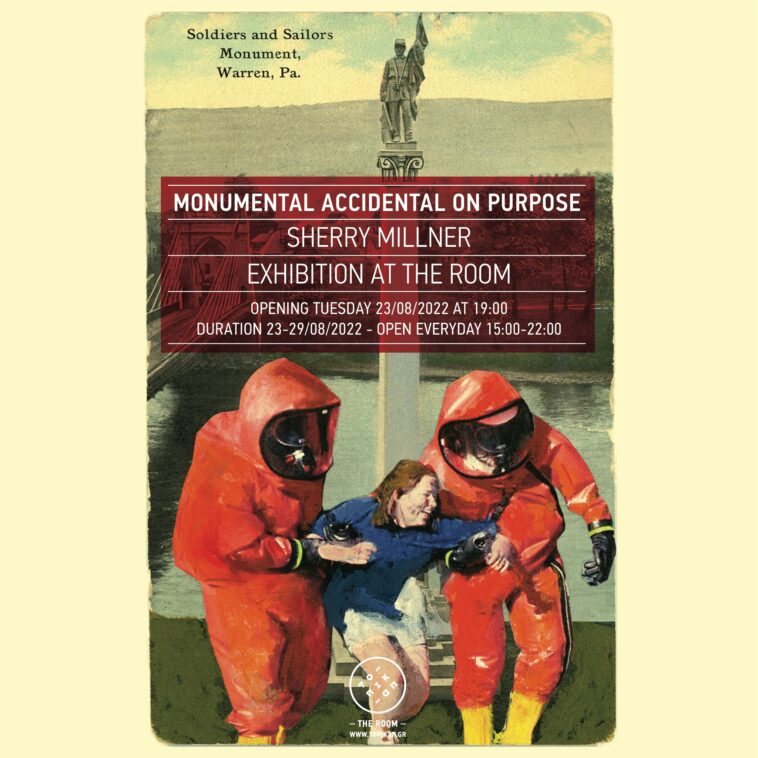Η έκθεση «Monumental Accidental on Purpose» της Sherry Millner καθώς και η προβολή έξι ταινιών μικρού μήκους των Ernie Larsen και Sherry Millner εγκαινιάζονται σήμερα 23 Αυγούστου στο «Πικάπ» (Ολύμπου 57) στη Θεσσαλονίκη και θα διαρκέσουν μέχρι τις 29 Αυγούστου. (Περισσότερες πληροφορίες στη σελίδα facebook To Pikap Kato)
Λίγα λόγια για την έκθεση
Οι καλλιτεχνικές εκτυπώσεις της Sherry Millner κρούουν έναν οπτικό κώδωνα κινδύνου. Όσες εκτίθενται επιλέχθηκαν μέσα από μια σειρά περισσοτέρων από 500 μετεστραμμένων καρτ ποστάλ που απεικονίζουν πανέμορφα άλλοτε φυσικά ή ανθρωπογενή τοπία τα οποία έχουν πληγεί από τη ρύπανση, τη μόλυνση, την κλιματική αλλαγή και από άλλες καταστροφικές κοινωνικές και ιστορικές συνθήκες που παράγονται από την αδυσώπητη ανάπτυξη του παγκόσμιου κεφαλαίου.
Οι εκτυπώσεις αυτές επιχειρούν μέσα από κολάζ και λαδοπαστέλ να παρουσιάσουν μετεστραμμένους τόπους και να απαντήσουν στην κυρίαρχη αμερικανική (λευκή) ιστορία και τις μυθικές της αναπαραστάσεις της αποικιοκρατίας, της γενοκτονίας, της σκλαβιάς και του συστημικού ρατσισμού.

Η κραυγή των αποκλεισμένων
Στα εγκαίνια της έκθεσης θα παρουσιαστεί επίσης το “The Clamor of the Excluded”, μια συλλογή έξι πολιτικών πειραματικών ταινιών μικρού μήκους, μεταξύ των οποίων και το “How Do Animals and Plants Live?”, σε συν-σκηνοθεσία των Sherry Millner και Ernie Larsen, οι οποίοι θα παρευρίσκονται. Οι ταινίες που επιλέχθηκαν έχουν σκοπό να μιλήσουν για ιδιαίτερες στιγμές κρίσης, από έξι διαφορετικές χώρες. Οι εικόνες και οι φωνές των αποκλεισμένων θρυμματίζουν την ομαλή επιφάνεια της καθημερινότητας.
Το πρόγραμμα:
J’ai Huit Ans/ I Am Eight Years Old
Olga Poliakoff & Yann Le Masson, France/Algeria, 1961, 8 min.
Secretly filmed in a refugee camp in Tunisia across the border from Algeria, banned for twelve years in France, this intimate documentary captures the trauma of the Algerian War as suffered by nine boys. Their drawings translate their wartime experiences to vividly portray the daily brutality of colonialist rule. Frantz Fanon pioneered the therapeutic approach in the camp that emphasized the crucial role of the boys’ image-memories in articulating their viscerally fragmented understanding of the ceaseless barrage of the French forces. Activist filmmaker Rene Vautier developed the scenario at Fanon’s urgent suggestion.
How Do Animals and Plants Live?
Millner & Larsen, Greece/U.S., 2021, 29 min.
An inquiry into the forcible eviction and demolition of the self-organized anarchist-supported migrant squat Orfanotrofeio in Thessaloniki, Greece, in July 2016.
An interview with a young West African migrant amid the bulldozed ruins of the old orphanage, performative translations from the Greek-language children’s schoolbook How Do Animals and Plants Live? that the filmmakers found amid the rubble when they broke into the ruined site—these and other elements (teddy bears, birds, a tied-up calf) are interwoven with unexpected visuals sparked by questions translated directly from the book, questions without real answers. Visuals that pointedly wonder: how is this possible? Asserting in four languages that “no one is illegal,” the visual essay valorizes the migrants’ self-organization, autonomy, solidarity, assembly, and direct action, at an historical moment when the status of the refugee has become and will remain a global paradigm.
Prayer of Fear
Mosireen Collective, Egypt, 2013, 4 min.
Amidst the Egyptian Revolt of 2013. Subjective flashes of street warfare and an unnamed woman plunging ahead as she recites a Mahmoud Ezzat poem, a lament for the victims of the clashes and massacres in and around Tahrir Square, forced by circumstances to question the value of martyrdom. The Mosireen Collective galvanized citizen media in the wake of President Mubarak’s fall, producing hundreds of searing videos, recently assembled into an archive of 858 hours.
Xochimilco 1914
Los Viumasters, Mexico, 2010, 4.5 min.
On the morning of December 4th, 1914, Pancho Villa and Emiliano Zapata met for the first time. An original stenographic record of their conversation, just hours before they took control of Mexico City, exists. A mere century later, this playful film animates the words of these revolutionary heroes and their historic repercussions.
Isle Of Flowers
Jorge Furtado, Brazil, 1989, 12:36 min.
Hailed as a masterpiece by Chris Marker and described by Furtado as a “letter to a Martian who knows nothing of the earth and its social systems,”the film uses inventive animation, a parodic mock-lecture style of narration, actors, and a corrosive conceptual structure, to link the urban bourgeois family to the rural poor who scavenge the garbage dump, the ‘isle of flowers,’ where pigs eat better than people.
41 Shots
Sherry Millner & Ernie Larsen, U.S., 2000, 14 min.
Portraying New York City as a necropolis, this video essay examines the police murder of West African migrant street peddler Amadou Diallo, in the context of then-Mayor (more recently Trump’s half-crazed drunken enabler) Rudy Guiliani’s exploitation of the racist “broken windows” theory and “zero tolerance” policy, in which the smallest infractions of the law must be enforced. The video displaces Diallo’s murder in the supposedly dangerous vestibule of the Bronx apartment building iin which he lived to 41 “safe” protected middle-class vestibules in central Manhattan. Diallo was hit by 19 bullets of the 41 shot by a special four-man unit of the police force. We see a 41 shot countdown to the outbreak of city-wide protest.



